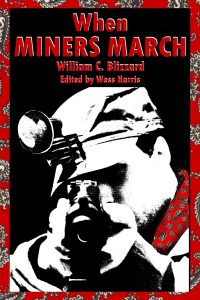By Theresa L. Burriss
Appalachian Heritage
Summer 2011
The recording and telling of history have proven to be troublesome for the critically-minded as inconsistencies, innocent mistakes, and downright lies plague much of what readers are given as purported fact. Of course as many realize, the “winners” or those in power have traditionally written history and delivered it in a neat, seemingly indisputable package. Fortunately, honest historians do exist and attempt to convey more accurate pictures of historical events, often working from a grassroots or “in the trenches” perspective that provides room for the typically forgotten or intentionally overlooked players.
William C. Blizzard offers readers just such a retelling of history that gets at the truth of the labor struggles leading up to the 1921 Battle of Blair Mountain in West Virginia. His work, When Miners March, first titled Struggle and Lose…Struggle and Win!, is well-researched and documented, offering court transcripts, newspaper articles, letters and written testimony from key players in the coalminers’ efforts to unionize West Virginia. The acquisition of the primary documents is due to William C. Blizzard’s familial association with the labor fight, namely his father Bill Blizzard’s role as a union organizer beginning as early as the Paint and Cabin Creek skirmishes in 1912-13.
Offering a comprehensive history of coal in West Virginia, Blizzard starts his work in 1817 with the discovery of coal in the Kanawha Valley and then methodically moves forward, documenting the trials and tribulations of the miners in a year-by-year timeline. He even offers an historical interlude with primary accounts of the Ludlow, Colorado, massacre, where women and children, in addition to miners, were killed indiscriminately. With Blizzard’s meticulous attention to detail, readers come to appreciate the decade’s long oppression exerted by the coal companies and understand how many local law enforcement agencies did the dirty bidding of those companies because they were paid handsomely to do so. Sheriff Don Chafin of Logan County is the most cited due to his ongoing ruthless oppression and often times outright murder of miners and their families. Even West Virginia’s governors were not above bribery and openly worked to suppress the miners through policy and legislation, both at the state and federal levels, more often than not resorting to lies about the miners and their tactics to justify such suppression.
In the telling Blizzard also disputes many formerly accepted “truths” about the labor movement. For example, several other historians have placed C. Frank Keeney, UMWA District 17 President, and Fred Mooney, District 17 Secretary-Treasurer, in the middle of the Battle of Blair Mountain, leading the charge instead of Bill Blizzard, Sr. As son William Blizzard documents, however, the two union leaders were far removed from the site because of fears that they would fall to the same fate as Sid Hatfield and Ed Chambers, who’d been murdered in broad daylight by Baldwin-Felts “detectives” or gun thugs on the steps of the McDowell County Courthouse. No one was ever brought to trial over these murders. William Petry, a UMWA organizer, explains, “Keeney and Mooney disappeared. Where they are I don’t know, but I’m assured they are safe from the hired gunmen at present” (308).
I must say that it helps to have a general understanding of the history of coal and labor in Appalachia before diving into this work. In fact, when teaching this work in college classes, I found my students responded to it much better after they read Denise Giardina’s historical fiction on the subject, Storming Heaven, and Diane Gilliam’s poetry companion, Kettle Bottom. The novel and poetry provided an entrée into the grittier details of When Miners March. My students noted that it’s easy to get lost in the dates and lose track of the names without having a previous understanding, and even so, they needed to process everything in class to fully grasp the import of Blizzard’s work. The history made a lasting impression on my students, however, when they visited many of the sites where the miners fought, set up tent colonies, and were buried. This experiential fieldtrip offered a holistic education for my students and I highly recommend it to fellow educators. Indeed, Blizzard’s work came to life as the students made connections between all those historical details and the tangible evidence before them.
For the scholar and labor historian, When Miners March
provides incredible insight into one of the most tumultuous times in
our nation’s labor history. For anyone who participates in any kind of
labor force, the work illustrates how much we owe to the coalminers of
Appalachia who lived, and often times died, to secure basic freedoms and
rights for all workers in the United States.







